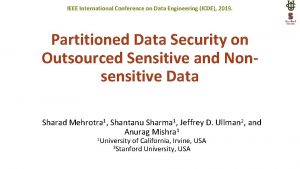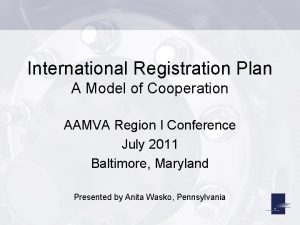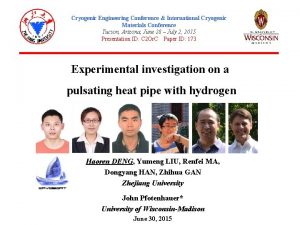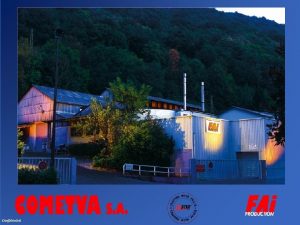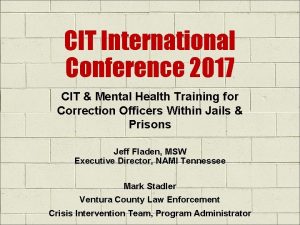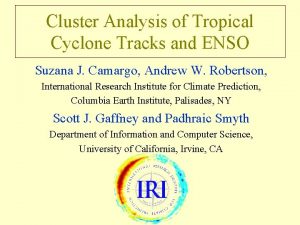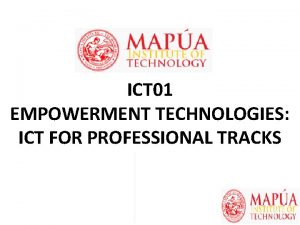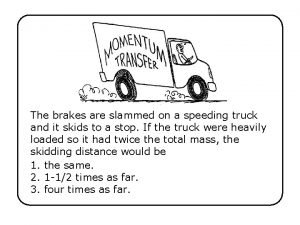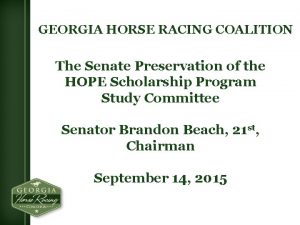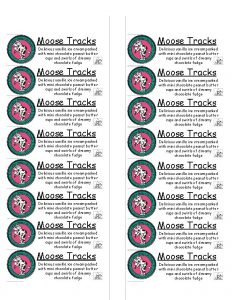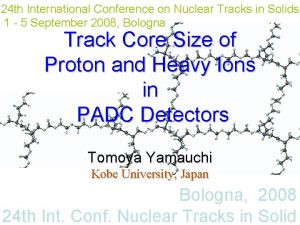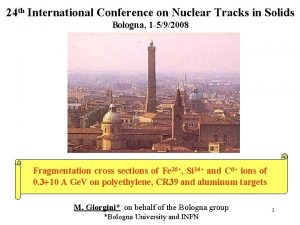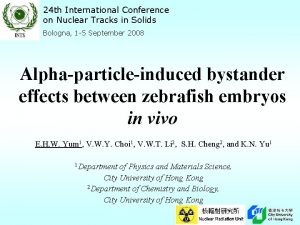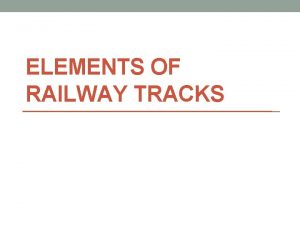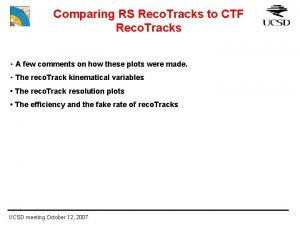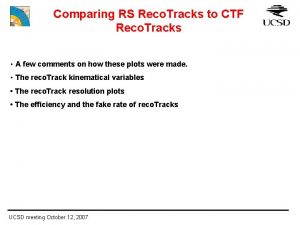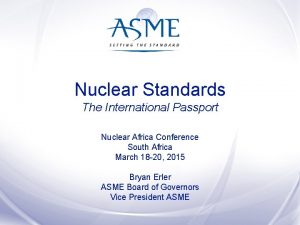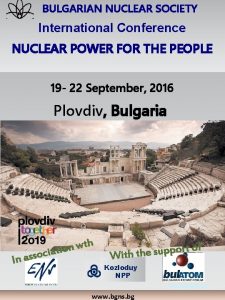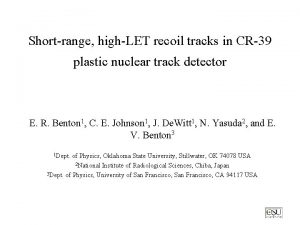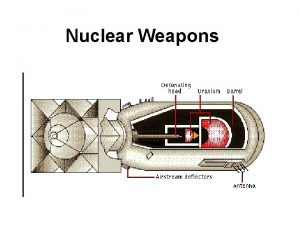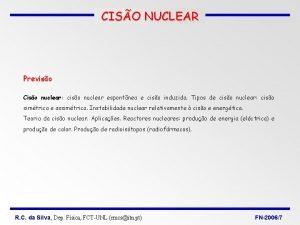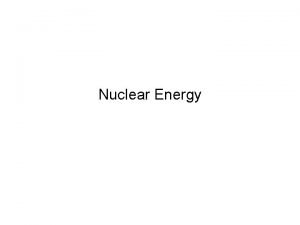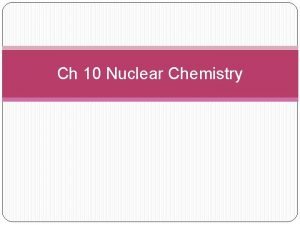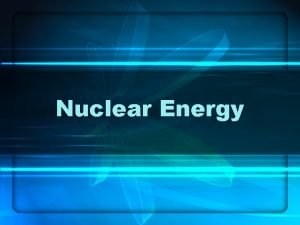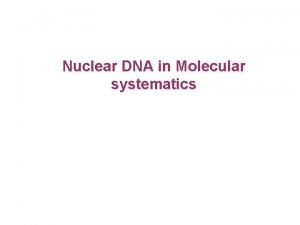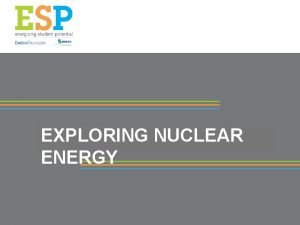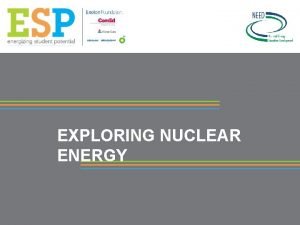24 th International Conference on Nuclear Tracks in























- Slides: 23

24 th International Conference on Nuclear Tracks in Solids Bologna, 1 -5 September 2008 Study of influence of catechins on bystander responses in alpha-particle radiobiological experiments using thin PADC films Y. L. Law and K. N. Yu Department of Physics and Materials Science, City University of Hong Kong

24 th International Conference on Objectives Nuclear Tracks in Solids Bologna, 1 -5 September 2008 1. To investigate the relationship between the radiation dose and induction of DNA damages in unirradiated cells 2. To investigate the scavenging effect of catechins on reactive oxygen species in unirradiated cells.

24 th International Conference on Introduction Nuclear Tracks in Solids Bologna, 1 -5 September 2008 Radiobiological effects of ionizing radiation Alpha particle • Interacts with DNA Double-strand breaks (DSBs) • Free radicals DSBs • Most lethal • Cell death, chromosome aberration, gene mutation…

24 th International Conference on Introduction Nuclear Tracks in Solids Bologna, 1 -5 September 2008 Catechins • Polyphenolic compounds in green tea • EGCG (epigallocatechin gallate) – most abundant • Cancer protection • Antioxidant effects • Scavengers of reactive oxygen species (ROS)

24 th International Conference on Introduction Nuclear Tracks in Solids Bologna, 1 -5 September 2008 Radiation-induced bystander effect Induction of biological effects in cells that are not directly traversed by an ionizing radiation Underlying mechanisms: 1. Gap junction-mediated intercellular communication 2. Soluble factor such as ROS released by irradiated cells

24 th International Conference on Introduction Nuclear Tracks in Solids Bologna, 1 -5 September 2008 Polyallyldiglycol carbonate (PADC) films -Most commonly used solid-state nuclear track detectors (SSNTDs) -Transparent -Relatively biocompatible -Does not dissolve in alcohol during sterilization Commercially available 100 µm thick PADC film

24 th International Conference on Methodology Set-up: PADC film cell dish 1000 µm PADC films + = 22 µm PADC film base cell dish Nuclear Tracks in Solids Bologna, 1 -5 September 2008

24 th International Conference on Nuclear Tracks in Solids Methodology Bologna, 1 -5 September 2008 Set-up: Alpha-particle irradiation 1000 µm PADC film 22 µm PADC film -particle beam nutritive medium Cell type : Chinese hamster ovary (CHO) Cell culture substrate : 22 & 1000 µm PADC films Alpha source : 241 Am (activity = 5 µCi and main alpha energy = 5. 49 Me. V under vacuum )

24 th International Conference on Nuclear Tracks in Solids Methodology 1 -particle irradiation Bologna, 1 -5 September 2008 2 add EGCG (in DMSO) 3 4 Trypsinize the cells BY cells only single cell Pelleted by centrifugation for TUNEL assay BY cells only

24 th International Conference on Methodology Nuclear Tracks in Solids Bologna, 1 -5 September 2008 TUNEL assay Terminal deoxynucleotidyl transferase d. UTP transferase-mediated nick end-labeling • Common method for detecting DNA fragmentation results from apoptosis • Identified by enzyme Td. T • d. UTPs – marker

24 th International Conference on Methodology: TUNEL assay Fixation Permeabilisation Nuclear Tracks in Solids Bologna, 1 -5 September 2008 Labeling reaction with TUNEL reaction mixture 2% paraformaldehyde in PBS – 1 h in RT To stabilize the cell – reaction stopped Flow Cytometry

24 th International Conference on Methodology: TUNEL assay Fixation Permeabilisation Nuclear Tracks in Solids Bologna, 1 -5 September 2008 Labeling reaction with TUNEL reaction mixture Flow Cytometry 0. 1% Triton X-100 and 0. 1% sodium citrate -10 min on ice Dissolve the cell membranes – allow larger dye molecules access into the cell

24 th International Conference on Methodology: TUNEL assay Fixation Permeabilisation Nuclear Tracks in Solids Bologna, 1 -5 September 2008 Labeling reaction with TUNEL reaction mixture 90% Label solution and 10% TUNEL enzyme - 37℃ in dark for 1 h Labels DNA strand breaks generated during apoptosis Flow Cytometry

24 th International Conference on Methodology: TUNEL assay Fixation Permeabilisation Nuclear Tracks in Solids Bologna, 1 -5 September 2008 Labeling reaction with TUNEL reaction mixture Flow Cytometry Detect and quantify fluorescein labels using laser beam Counting of 10000 cells

24 th International Conference on Nuclear Tracks in Solids Methodology Bologna, 1 -5 September 2008 1 2 Fixation IR cells 3 Etching 4 37℃ Capture image of tracks and cells 14 N KOH solution

24 th International Conference on Nuclear Tracks in Solids Results and Discussions Number of cell hits Bologna, 1 -5 September 2008 CHO cells Alpha-particle track After fixation After etching (CHO cells only) (CHO cells and tracks)

24 th International Conference on Results and Discussions Number of cell hits Nuclear Tracks in Solids Bologna, 1 -5 September 2008 • As low as 1% of the cell nuclei were actually traversed by alpha particles in all the samples • Bystander damages occur even at very low doses • DNA damages in bystander cells seems to be independent of the number of irradiated cells

24 th International Conference on Nuclear Tracks in Solids Results and Discussions Results of TUNEL assay Bologna, 1 -5 September 2008 * * For example: Bystander sample = 33. 75% Unirradiated control = 17. 22% ** Result: 16. 33% of TUNEL positive signal 0 μM 10 μM 20 μM *P < 0. 05, **P < 0. 005 compared to the corresponding control (0 μM)

24 th International Conference on Nuclear Tracks in Solids Results and Discussions Results of TUNEL assay Bologna, 1 -5 September 2008 Signal transduction from irradiated cells to bystander cells occurred within a short time * * ** Without any treatment 0 μM 10 μM 20 μM *P < 0. 05, **P < 0. 005 compared to the corresponding control (0 μM)

24 th International Conference on Nuclear Tracks in Solids Results and Discussions Results of TUNEL assay Bologna, 1 -5 September 2008 * * ** 0 μM 10 μM 20 μM *P < 0. 05, **P < 0. 005 compared to the corresponding control (0 μM)

24 th International Conference on Results and Discussions Results of TUNEL assay Nuclear Tracks in Solids Bologna, 1 -5 September 2008 • Scavenging effect of EGCG in 1 μM on bystander cells is the most significant • Previous study showed EGCG significantly reduced the amount of DNA strand breaks in 1 -2 μM concentrations (Anderson et al. , 2001) • ROS might be involved in the induction of DNA breaks Anderson, R. F. , Fisher, L. J. , Hara, Y. , Harris, T. , Mak, W. B. , Melton, L. D. , Packer, J. E. , 2001. Green tea catechins partially protect DNA from OH radical-induced strand breaks and base damage through fast chemical repair of DNA radicals. Carcinogenesis. 22(8), 1189 -93.

24 th International Conference on Conclusions Nuclear Tracks in Solids Bologna, 1 -5 September 2008 • Bystander damages occur at very low doses • The signal transduction from irradiated cells to unirradiated cells occur within a short time after irradiation • EGCG scavenges ROS at a significant level in the bystander cells produced by alpha-particles irradiation • Further study is needed to find out which types of ROS are involved in the medium-mediated bystander effects.

24 th International Conference on Nuclear Tracks in Solids Bologna, 1 -5 September 2008 Study of influence of catechins on bystander responses in alpha-particle radiobiological experiments using thin PADC films Y. L. Law and K. N. Yu Thank you!
 Fisión nuclear vs fision nuclear
Fisión nuclear vs fision nuclear Lesson 15 nuclear quest nuclear reactions
Lesson 15 nuclear quest nuclear reactions Aerotech conference
Aerotech conference International telemetry conference
International telemetry conference Asbo international conference
Asbo international conference Icde 2019
Icde 2019 Aamva international conference
Aamva international conference International cryogenic materials conference
International cryogenic materials conference International catholic conference of scouting
International catholic conference of scouting International ferroalloys conference
International ferroalloys conference International gambling conference
International gambling conference International space development conference
International space development conference Cit healthcare conference 2017
Cit healthcare conference 2017 Career level accenture
Career level accenture Tams sat score
Tams sat score Tracks
Tracks Shsu kat tracks
Shsu kat tracks Empowerment technologies ict for professional tracks
Empowerment technologies ict for professional tracks Tram track appearance
Tram track appearance Pgp goals arkansas
Pgp goals arkansas Two smooth tracks of equal length have bumps
Two smooth tracks of equal length have bumps Wagon tracks welding
Wagon tracks welding Core subjects in shs
Core subjects in shs Horse racing in georgia
Horse racing in georgia





